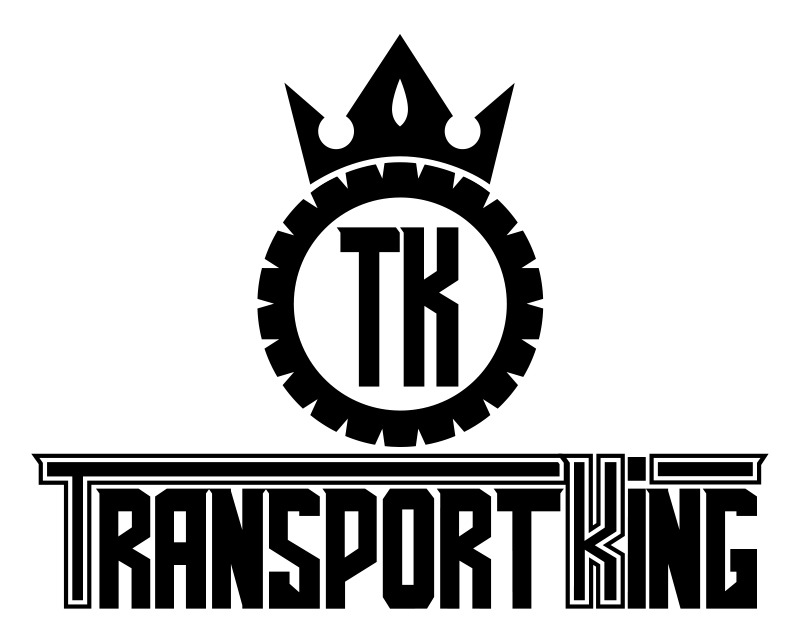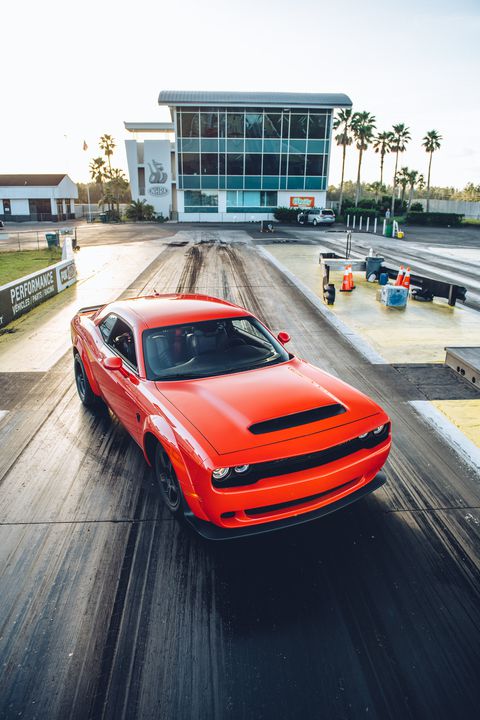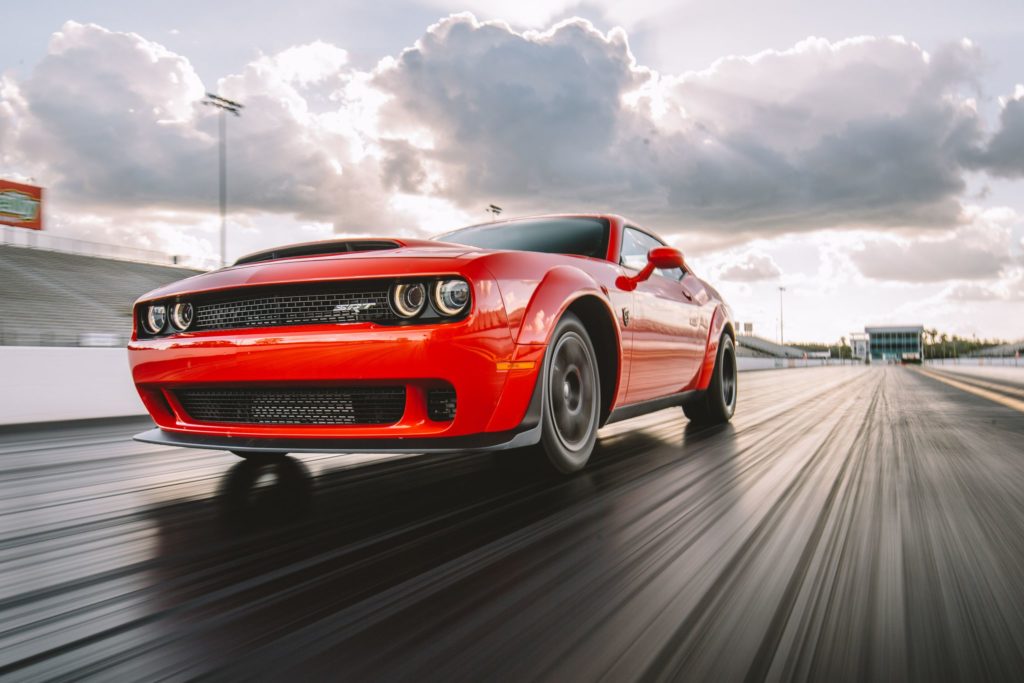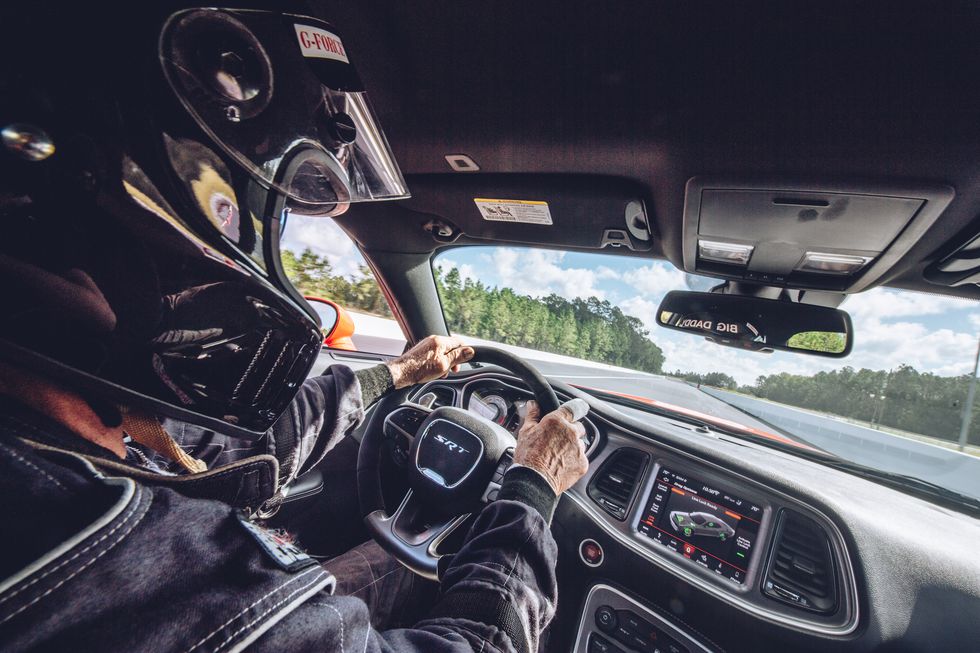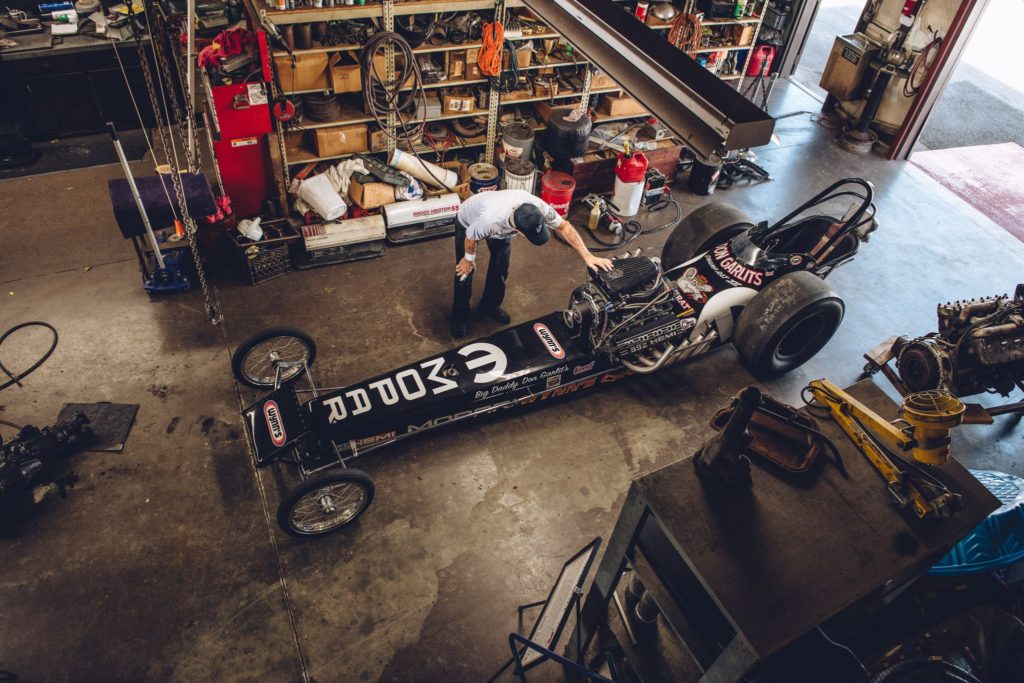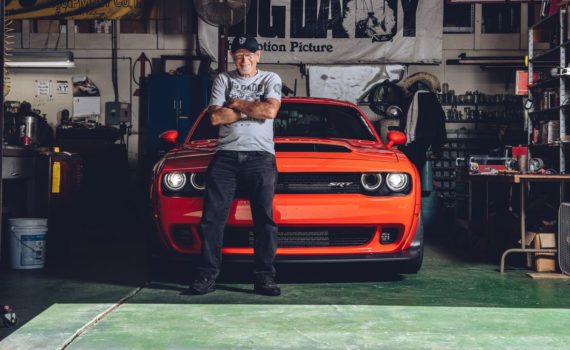
The Demon and Don Garlits
Don “Big Daddy” Garlits is the most innovative man in drag racing history. For him, wrangling the 840-horsepower Dodge Challenger SRT Demon is a piece of cake.
It’s a bright morning at Gainesville Raceway, muggy, like most fall days in Florida, like the state is midway through a dishwasher cycle. The stands are empty, the facility populated by little more than a magazine photography crew and a handful of track workers. But the place is full of noise, valves springing and exhaust flowing and induction inducting. One car, a Dodge Challenger SRT Demon, is ripping off passes on the drag strip.
Behind the wheel is a small man in a black crash helmet. The words “Big Daddy” are stenciled across the front in chunky white letters. The car is a rakish nightmare, narrow tires up front and oil-drum semislicks out back; the latter cast off bales of smoke whenever the Demon rolls to the starting line. With every pass, the front end yawns farther from the ground, the rear tires bunch up more violently, full throttle comes on sooner. After a dozen runs, the car coasts into the staging area.
“That’s as quick as you can get after it,” Don Garlits says, climbing out of the cockpit. “If I step on it any sooner, it spins.” Nobody is going to argue the point.
Garlits, the man they call “Big Daddy,” is the greatest drag racer in history. Now 86, he lorded over the sport from the early 1960s to the late 1980s, winning every event of consequence, routinely obliterating speed records and racking up national championships. Incredibly, he did all of this inside race cars of his own design and manufacture, a series of pioneering, Hemi-powered dragsters dubbed “Swamp Rat.”
So when the Hemi-powered Demon set a new production-car quarter-mile record—9.65 seconds at 140 mph, confirmed by the National Hot Rod Association—Big Daddy came to mind. We dropped him a line, proposing to bring together the two drag-racing titans in his home state. Dodge agreed to provide a preproduction test car. It also sent Jim Wilder, an SRT engineer and amateur drag racer, to chew the fat.
There’s plenty to digest. Based on the 707-hp Challenger SRT Hellcat, the Demon is the most extreme street-legal factory drag-racing proposition ever built. The 6.2-liter supercharged V8 features a new block, pistons, and connecting rods. There’s a higher redline, dual fuel pumps, and a larger blower pushing more boost. The torque converter, driveshaft, axles, differential, and rear gears are all beefed up. Line lock holds the front wheels independently for tire-warming burnouts, and a dedicated transmission brake allows quicker launches. Drag Mode, a setting in the car’s electronic management system, stiffens the rear dampers to aid weight transfer, “prefills” the supercharger to 8 psi, and diverts A/C refrigerant from the cabin to ice down the fluid in the engine’s liquid-to-air intercooler. Hollow anti-roll bars, smaller 18-inch wheels, reduced sound deadening, and a minimalist cockpit drop curb weight.
All told, Wilder says the Demon is about 200 pounds lighter than the Hellcat, not counting the tire-rubber marbles it has so obviously lost. The pièce de résistance is what Wilder calls “the crate,” a factory-delivered, 42-by-34-by-18-inch black box with glinting metal fasteners. It costs $1 and girds the Demon for dragstrip battle. Inside are supernarrow front wheels, a floor jack, an impact wrench, an air filter, and assorted hand tools. Also a controller that allows you to unlock special high-octane fuel mapping for the engine-management system. Duly equipped, the car is a terror. It pumps out 840 hp and 770 lb-ft of torque. On a cool day at a tacky strip, the Demon pulls wheelies and sees 60 mph in 2.3 seconds. Were the car any more awesome, its ignition chime would be a Steve Vai guitar solo.
Garlits is impressed. In the paddock, he circles the Dodge, sizing it up. It’s a rangy monstrosity, with a taller hood and wider rubber than the Hellcat. The rear tires necessitate gargantuan rear fender flares. When Garlits shoves an arm into a wheel well to inspect them, the car appears to swallow him whole. He works methodically, examining the suspension and aero pieces like diamonds or produce. He won’t drive a bomb—what he sometimes calls a drag car—without doing so. When Garlits started racing in 1950, volatile nitromethane and benzene fuels were still mixed trackside by trial and error. Front-engine “slingshot” dragsters, with the cockpit behind the rear axle, wore skyscraping superchargers, limiting forward visibility. Tire shake often knocked drivers unconscious. Safety was all but nonexistent. Period photos show men in T-shirts driving through debris storms at 150 mph.
Predictably, calamity is central to the Big Daddy legend. This is a man who has nearly burned to death twice, trapped inside a nitro fireball after high-speed engine explosions. One particularly harrowing incident, a planetary-gearbox failure at 25,000 rpm, mutilated his lower legs. Another time, a parachute failure at 200 mph sent Swamp Rat 6-B blasting through a metal fence, breaking Garlits’s spine. The dragster rolled, went airborne, and landed across a set of nearby railroad tracks. Spectators pulled him from the wreckage.
“It’s a funny feeling, to wake up not knowing what’s happened,” he said, tugging on the aftermarket roll cage fitted to the Demon for our test. “You never do get used to that.”
Pieces came off along the way. Bits of fingers. Toes. Half his right foot. There’s a slight hitch in his short, purposeful stride. One of his ears is dead, and the other has a hearing aid snugged inside. His eyes have been surgically repaired; repeat violent descents from 300 mph caused his retinas to detach.
None of this appears to have slowed the man down. Two weeks before I met Garlits, Hurricane Irma felled a massive oak in front of his house. He promptly marched outside with a chain saw, cut it into pieces, and built a bonfire. In Gainesville, he hops into the quickest mass-production car ever made, no drama or pomp, and drives the hell out of it. He has few notes.
Works fine,” he says, pulling off his helmet. He is grinning. He likes the suspension tuning and how the Demon transfers weight rearward. He likes that it looks and sounds good. Mostly, he’s impressed that the Dodge runs zero-weight oil and offers a 60,000-mile warranty.
“You see, I built all my own [Hemi engines]. I knew the limitations . . . when the plugs start fuzzing up, burning the electrodes a bit, and you know if you go any further, it’s going to destruct,” Garlits says, growing animated.
“That’s why I can’t do this racing they do today, with all the qualifying. I refuse to go into my shop, take the finest materials on the planet, made by the finest machinists, where the tolerances are zero, time it to within a half-degree, then bring it out here and blow it to bits getting into the show. Nah.”
Altogether, he says, the Demon is a “pretty cool deal.”
“It’s hard to believe this is a street car. . . . We never dreamed the factory would build anything like this. When we started out, there was a big no-no about factory participation, about acknowledging the sport,” he says. “Could use a taller rear tire, though. That would help tremendously with traction.”
Then he stands in the shade, under the awning of an empty grandstand, crash helmet in hand. Waiting, politely, to be called to the next part of our shoot, which he treats matter-of-factly, like any other job. Garlits is not chatty unless asked to be chatty. He is not a showman unless asked to put on a show. He seems to recognize, almost innately, the business in the moment. When asked for a burnout, he does the biggest, dankest mother of a burnout you have ever seen. When asked for ride-alongs, he leaves passengers with bright, unforgettable memories. When approached with a question, he paws through his brain’s catalog, selects the story that best serves as an answer, and delivers it with gusto.
It only later occurs to me: This is Big Daddy, the first paid professional drag racer, the sport’s biggest and most sellable personality, hard at work. And a stark reminder of how drag racing’s giants made their bones—professionalism and heroic feats turned workaday, but also canny marketing, tilting the industry around that skill earlier and better than any other group of paid drivers.
Garlits didn’t want to be a drag racer. He obviously enjoys winning but says he does not like speed and fear. He was born in Tampa in 1932. As an infant, he slept on the dirt floor of a toolshed. His father, a former Westinghouse engineer, moved to Florida in 1927 to chase the fruit-farming boom, only to become one of the era’s “forgotten men” when the bank went under and lost his savings. Diseased flies then ravaged the family farm. To contain the infestation, the Department of Agriculture showed up, sprayed the crops with kerosene, and burned them while the family watched.
Garlits grew to like tinkering. When he was a boy, the other boys paid him to work on their bicycles, and he took that money and bought model airplanes, so he could tinker with those. After high school, he started tinkering with radiators and fenders. He happened to be good at tinkering with nitro fuel and Hemi engines, so he opened a race shop in Tampa. He tried to stop, to remove himself from the cockpit, numerous times. Invariably, the ’shoes hired to pilot Swamp Rat in his place were either fired or quit, forcing Garlits to fulfill contractual obligations by climbing back behind the wheel. He drove professionally for six decades. But if he had his druthers, he’d never climb into a dragster, only build them and handle the business.
The morning after running the Demon at Gainesville, we meet at Garlits’s base of operations in Ocala, an hour south. He relocated there in the 1980s, after amassing more than $4 million in race winnings. One sprawling tract encompasses the Don Garlits Museum of Drag Racing and an ancillary antique-road-car exhibit, plus a smattering of garages and a personal workshop. The bunker-like complex sits behind a high fence, tucked inside an industrial park, backing onto the freeway.
Garlits’s hands are already greasy when I arrive. He still turns wrenches every day, still tours year-round, driving a 60-foot truck and trailer, hauling various iterations of Swamp Rat to appearances across the country. But he is quick to mention interests beyond racing. That started with bookkeeping, which he’s always kept in-house, both at the old Tampa shop and the museum.
“Because I like accounting, I studied world economics, so I know how the money systems work—most people don’t understand the money at all. I also like religion and archeology. I studied human origins, all the stuff the mainstream media stays away from. There’s so much stuff here that’s unexplainable.”
Some of Garlits’s views on those matters are unconventional. Among them, a belief that beings from another planet populated Earth millions of years ago, before getting “wiped out in some cataclysmic event.” During the two days we spend together, he mentions man-made items discovered inside geodes and secondhand encounters with extraterrestrials. And he relays anecdotes that beg to be shared in whole, because they defy easy summary. Example:
“My friend Bob Lazar, he . . . got a job in Area 51, in the Papoose Lake area. They would fly him out, put him in a bus with the windows blanked out, and drive into the desert. They had these mountains—they looked like mountains, but they were actually hangars. This was in the 1980s, and [the United States] had in our possession at that time eight or nine flying saucers. Some of them were really old, dug up out of the ground. One was brand spanking new, a runnable model.
“[Lazar] never saw any aliens; they kept those away from him. But his job, and 20 other guys’, was to figure out the propulsion system. They figured it out pretty much right away, but they didn’t have the materials here to actually replicate it. It runs on an element we don’t have on this planet, ‘115,’ he called it. . . . Now, mind you, these were not interplanetary vehicles, just back and forth to a big mother ship that orbits. They don’t bring it to the ground. It would cause problems.
“It runs on electricity. [Lazar] got a drawing made by an artist in California, best he could remember. I’ve got a copy. The thing’s about the size of a baseball and generates enough electricity to power up New York City, and you can lay your hands on it, running, and it just gets warm. See, we don’t know anything about technology like that. That’s really far out.”
To which you can only stand there and blink a few times and say, “Yes, Don. Yes, it is
Some in drag-racing circles dismiss Garlits’s penchant for the bizarre as a quirk. Others believe it’s a psych-out technique, part of the Big Daddy persona. NHRA champion Shirley Muldowney, a longtime friend and rival, once suggested that prolonged exposure to nitro fumes made Garlits “funny in the head.” (In fairness, she said this after Garlits reportedly began stringing a leather thong with animal teeth, which he said were magical, and rubbing them for luck.)
“I just need information, I guess,” he says. He pauses to consider, something he does not often do in conversation. “Yeah. That’s it. I can’t get enough information. I don’t know any other answer. What keeps me going is, my mind is always running . . . there’s just so much we don’t know.”
The man certainly has a unique relationship with progress. At the track, he bemoaned modern drag racing, the dependence on computerization, and “crew chiefs sitting in air-conditioned rooms.” But during his Top Fuel career, Garlits’s ability to recognize the value of new technologies was uncanny; he appeared to believe in ruthless innovation, bent on advancing the sport.
Garlits once remarked that every bit of clever engineering on the NHRA grid came from something he did first. It was only a slight exaggeration. His contributions run the gamut—safety, aerodynamics, materials—but are most evident in Swamp Rat 14, the first successful rear-engine dragster. He started designing it from a hospital bed, after the gearbox catastrophe in 1970. Development stalled when he was released.
“I put together a brand-new slingshot, the latest double-throwdown deal, and we’re putting the body on it outside the shop. My wife, Pat, comes out. She knew what it was, because she was the comptroller [at the Tampa shop], and there was no deposit for a new front-engine car. I said, ‘Honey, that’s my car for 1971. In two weeks I’ve got to be in Long Beach, on an IHRA contract.’ She says, ‘You would get back in one of these things after it killed six of your friends in the past two years?’ I said, ‘Honey, this is what I do.’ She says, ‘These machines are dangerous. Now get back on the rear-engine car.’ ”
source:http://www.roadandtrack.com/car-culture/a15933028/don-garlits-dodge-challenger-srt-demon/
